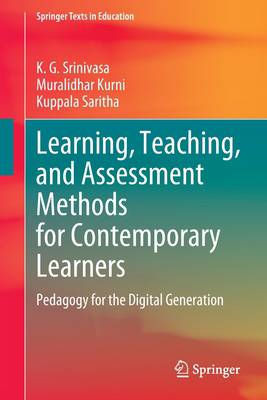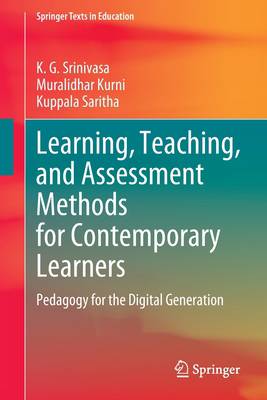
- Retrait gratuit dans votre magasin Club
- 7.000.000 titres dans notre catalogue
- Payer en toute sécurité
- Toujours un magasin près de chez vous
- Retrait gratuit dans votre magasin Club
- 7.000.0000 titres dans notre catalogue
- Payer en toute sécurité
- Toujours un magasin près de chez vous
Learning, Teaching, and Assessment Methods for Contemporary Learners
Pedagogy for the Digital Generation
K G Srinivasa, Muralidhar Kurni, Kuppala Saritha
167,95 €
+ 335 points
Description
Chapter 1. Introduction 1.1. What is Pedagogy? 1.2. Why Pedagogy is Important? 1.3. Different Types of Pedagogies 1.4. How is Pedagogy Changing? 1.5. How does pedagogy impact the learner? 1.6. Modern learning, teaching, and assessment methods 1.6.1. Crossover Learning 1.6.2. Learning Through Collaborative Argumentation 1.6.3. Incidental Learning 1.6.4. Context-Based Learning 1.6.5. Computational Thinking 1.6.6. Learning by Doing 1.6.7. Embodied Learning 1.6.8. Adaptive Teaching/Learning 1.6.9. Analytics of Emotions 1.6.10. Stealth AssessmentChapter 2. Crossover Learning 2.1. What is Crossover Learning? 2.2. Why is it good to implement? 2.3. Why is Crossover Learning Working in the Classroom? 2.4. How to implement it? 2.5. Limitations / Major Barriers and Disadvantages of adopting Crossover Learning 2.6. Case Studies
Chapter 3. Learning Through Collaborative Argumentation 3.1. What is Collaborative Argumentation? 3.2. Benefits of Argumentation 3.3. Techniques for Effective Collaborative Argumentation 3.4. Preparing Classroom Environments for Collaborative Argumentation 3.5. Case Studies
Chapter 4. Incidental Learning 4.1. What is Incidental Learning? 4.2. What is the Impact of Incidental Learning? 4.3. How to Engage with Incidental Teaching? 4.4. Incidental Learning in the Classroom 4.5. Incidental Learning and Intentional Learning 4.6. Informal and Intentional Learning 4.7. Case Studies
Chapter 5. Context-Based Learning 5.1. What is Context-Based Learning? 5.2. Why Context-Based Learning? 5.3. Context-Based Learning and Competence 5.4. Impact on Students' Learning 5.5. Creating Context-Based Learning Environments 5.6. Connecting Concepts and Contexts 5.7. Selection of Contexts 5.8. Assessment in context-based teaching and learning 5.9. Case Studies
Chapter 6. Computational Thinking 6.1. What is Computational Thinking? 6.2. Why Computational Thinking is important? 6.3. Key Skills for Computational thinking 6.4. Six Principles of Computational Thinking 6.5. Learning Strategies for Developing Computational Thinking Skills 6.6. Computational thinking in practice 6.7. Thinking computationally 6.8. Assessment of computational thinking 6.9. Case Studies
Chapter 7. Learning by Doing 7.1. What is Learning-by-doing? 7.2. Why Learning-by-doing is important? / Why is Learning-by-doing effective? 7.3. What We Learn When We Learn by Doing
Chapter 3. Learning Through Collaborative Argumentation 3.1. What is Collaborative Argumentation? 3.2. Benefits of Argumentation 3.3. Techniques for Effective Collaborative Argumentation 3.4. Preparing Classroom Environments for Collaborative Argumentation 3.5. Case Studies
Chapter 4. Incidental Learning 4.1. What is Incidental Learning? 4.2. What is the Impact of Incidental Learning? 4.3. How to Engage with Incidental Teaching? 4.4. Incidental Learning in the Classroom 4.5. Incidental Learning and Intentional Learning 4.6. Informal and Intentional Learning 4.7. Case Studies
Chapter 5. Context-Based Learning 5.1. What is Context-Based Learning? 5.2. Why Context-Based Learning? 5.3. Context-Based Learning and Competence 5.4. Impact on Students' Learning 5.5. Creating Context-Based Learning Environments 5.6. Connecting Concepts and Contexts 5.7. Selection of Contexts 5.8. Assessment in context-based teaching and learning 5.9. Case Studies
Chapter 6. Computational Thinking 6.1. What is Computational Thinking? 6.2. Why Computational Thinking is important? 6.3. Key Skills for Computational thinking 6.4. Six Principles of Computational Thinking 6.5. Learning Strategies for Developing Computational Thinking Skills 6.6. Computational thinking in practice 6.7. Thinking computationally 6.8. Assessment of computational thinking 6.9. Case Studies
Chapter 7. Learning by Doing 7.1. What is Learning-by-doing? 7.2. Why Learning-by-doing is important? / Why is Learning-by-doing effective? 7.3. What We Learn When We Learn by Doing
Spécifications
Parties prenantes
- Auteur(s) :
- Editeur:
Contenu
- Nombre de pages :
- 342
- Langue:
- Anglais
- Collection :
Caractéristiques
- EAN:
- 9789811967337
- Date de parution :
- 30-10-22
- Format:
- Livre broché
- Format numérique:
- Trade paperback (VS)
- Dimensions :
- 156 mm x 234 mm
- Poids :
- 503 g

Les avis
Nous publions uniquement les avis qui respectent les conditions requises. Consultez nos conditions pour les avis.






